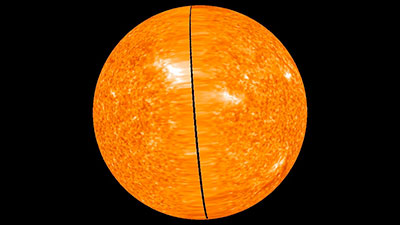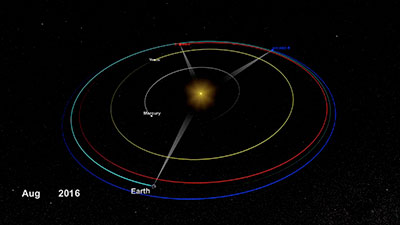After Seventeen Years, A Spacecraft Makes Its First Visit HomeOn Aug. 12, 2023, NASA's STEREO-A spacecraft will pass between the Sun and Earth, marking the first Earth flyby of the nearly 17-year-old mission. The visit home brings a special chance for the spacecraft to collaborate with NASA missions near Earth and reveal new insights into our closest star.
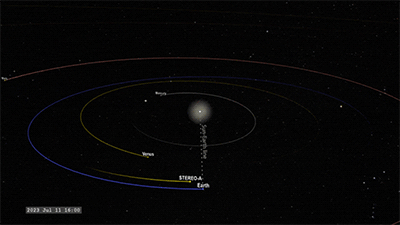
Above: NASA's STEREO-A spacecraft will cross the Sun-Earth line on Aug. 12, 2023. The crossing comes one day before Venus passes between the Sun and Earth, though the planet will appear 10 degrees below the Sun from Earth's view and outside of STEREO-A's field of view. (NASA's Goddard Space Flight Center/Scientific Visualization Studio/Tom Bridgman)
The twin STEREO (Solar TErrestrial RElations Observatory) spacecraft launched on Oct. 25, 2006, from the Cape Canaveral Air Force Station in Florida. STEREO-A (for "Ahead") advanced its lead on Earth as STEREO-B (for "Behind") lagged behind, both charting Earth-like orbits around the Sun.
During the first years after launch, the dual-spacecraft mission achieved its landmark goal: providing the first stereoscopic, or multiple-perspective, view of our closest star. On Feb. 6, 2011, the mission achieved another landmark: STEREO-A and -B reached a 180-degree separation in their orbits. For the first time, humanity saw our Sun as a complete sphere.
"Prior to that we were 'tethered' to the Sun-Earth line – we only saw one side of the Sun at a time," said Lika Guhathakurta, STEREO program scientist at NASA Headquarters in Washington, D.C. "STEREO broke that tether and gave us a view of the Sun as a three-dimensional object."
The mission accomplished many other scientific feats over the years, and researchers studied both spacecraft views until 2014, when mission control lost contact with STEREO-B after a planned reset. However, STEREO-A continues its journey, capturing solar views unavailable from Earth.
On Aug. 12, 2023, STEREO-A's lead on Earth has grown to one full revolution as the spacecraft "laps" us in our orbit around the Sun. In the few weeks before and after STEREO-A's flyby, scientists are seizing the opportunity to ask questions normally beyond the mission's reach.
A 3D View of the Sun
During the Earth flyby, STEREO-A will once again do something it used to do with its twin in the early years: combine views to achieve stereoscopic vision.
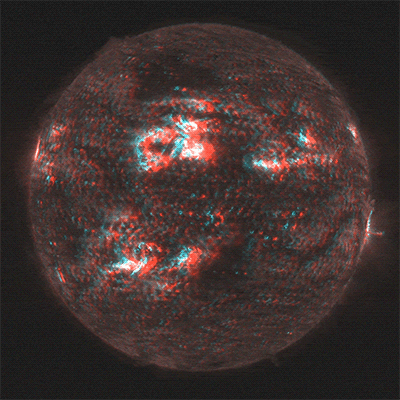
Above: Stereoscopic vision is what's behind 3D movies, as two slightly offset images are overlaid, and red-blue 3D glasses ensure each eye perceives only one of the images. Readers with such glasses will perceive this view of the Sun, created from combining views of the Sun captured by STEREO-A and NASA's Solar Dynamics Observatory (SDO) on July 6, 2023. (NASA's Goddard Space Flight Center/Scientific Visualization Studio/Tom Bridgman)
Stereoscopic vision allows us to extract 3D information from two-dimensional, or flat, images. It's how two eyeballs, looking out at the world from offset locations, create depth perception. Your brain compares the images from each eye, and the slight differences between those images reveal which objects are closer or farther away.
STEREO-A will enable such 3D viewing by synthesizing its views with NASA's and the European Space Agency's Solar and Heliospheric Observatory (SOHO) and NASA's Solar Dynamics Observatory (SDO). Better yet, STEREO-A's distance from Earth changes throughout the flyby, optimizing its stereo vision for different sized solar features at different times. It's as if scientists were adjusting the focus on a several million-mile-wide telescope.
STEREO scientists are using the opportunity to make much-needed measurements. They are identifying active regions, the magnetically complex regions underlying sunspots, hoping to uncover 3D information about their structure usually lost in 2D images. They'll also test a new theory that coronal loops – giant arches often seen in close-up images of the Sun – aren't what they appear to be.
"There is a recent idea that coronal loops might just be optical illusions," said Terry Kucera, STEREO project scientist at NASA's Goddard Space Flight Center in Greenbelt, Maryland. Some scientists have suggested that our limited viewing angles make them appear to have shapes they may not truly have. "If you look at them from multiple points of view, that should become more apparent," Kucera added.
Inside a Solar Eruption
It's not just what STEREO-A will see as it flies by Earth, but also what it will "feel," that could lead to major discoveries.
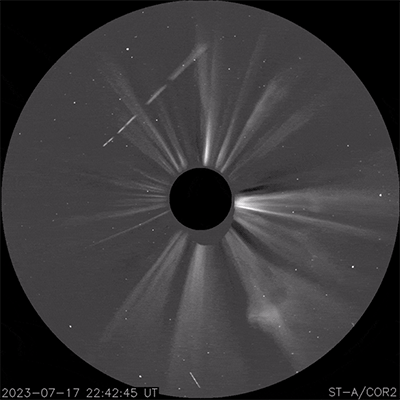
Above: This coronagraph image shows a coronal mass ejection escaping the Sun, which is occluded behind the black circle at the center of the image. STEREO-A imaged this Earth-directed CME eruption on July 17, 2023. The CME was captured by the COR2 instrument on STEREO-A at the highest cadence (2.5 mins) ever achieved by a coronagraph. (NASA/STEREO-A/SECCHI)
When a plume of solar material known as a coronal mass ejection, or CME, arrives at Earth, it can disrupt satellite and radio signals, or even cause surges in our power grids. Or, it may have hardly any effect at all. It all depends on the magnetic field embedded within it, which can change dramatically in the 93 million miles between the Sun and Earth.
To understand how a CME's magnetic field evolves on the way to Earth, scientists build computer models of these solar eruptions, updating them with each new spacecraft observation. But a single spacecraft's data can only tell us so much.
"It's like the parable about the blind men and the elephant – the one who feels the legs says 'it's like a tree trunk,' and the one who feels the tail says 'it's like a snake,'" said said Toni Galvin, a professor at the University of New Hampshire and principal investigator for one of STEREO-A's instruments. "That's what we're stuck with right now with CMEs, because we typically only have one or two spacecraft right next to each other measuring it."
During the months before and after STEREO-A's Earth flyby, any Earth-directed CMEs will pass over STEREO-A and other near-Earth spacecraft, giving scientists much-needed multipoint measurements from inside a CME.
A Fundamentally Different Sun
STEREO-A was also close to Earth in 2006, shortly after launch. That was during "solar minimum," the low-point in the Sun's roughly 11-year cycle of high and low activity.
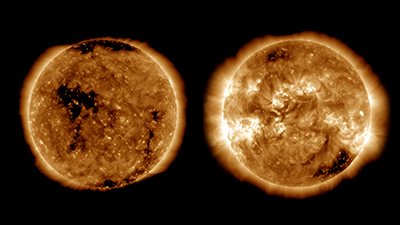
Above: Images from NASA's Solar Dynamics Observatory show the Sun at solar minimum in October 2019 (left) and the last solar maximum in April 2014 (right). Dark coronal holes cover the Sun during solar minimum, while bright active regions—indicating more solar activity—cover the Sun during solar maximum. (NASA's Solar Dynamics Observatory/Joy Ng)
"The Sun was so quiet at that point! I was looking back at the data and I said 'Oh yeah, I recognize that active region' – there was one, and we studied it," Kucera said, laughing. "OK, it wasn't quite that bad – but it was close."
Now, as we approach solar maximum predicted for 2025, the Sun isn't quite so sleepy.
"In this phase of the solar cycle, STEREO-A is going to experience a fundamentally different Sun," Guhathakurta said. "There is so much knowledge to be gained from that."












